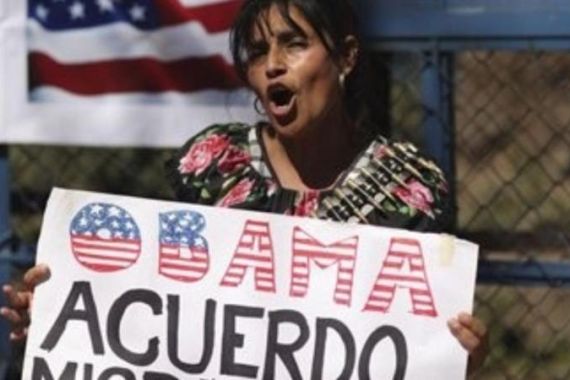The US should release thousands, not hundreds of detainees
The government is releasing only hundreds – who represent a small fraction of the daily average detainee population.

In light of impending cuts to the federal budget, federal immigration officials released hundreds of detainees from immigration detention facilities across the United States this week.
This move, designed to cut spending, has created a sense of alarm in certain quarters. Republican Bob Goodlatte from Virginia, who is chairman of the House Judiciary Committee, was critical of the move. On Tuesday, he stated:
By releasing criminal immigrants onto the streets, the administration is needlessly endangering American lives…. It also undermines our efforts to come together with the administration and reform our nation’s immigration laws.
This response is misguided as there is scant evidence that immigrant detainees are dangerous.
Some may find it shocking that the US government is releasing prisoners. However, immigrant detainees in the US are civil, not criminal, detainees. They are being held as they wait for their immigration hearing or their deportation. They are not being held on criminal grounds. Many immigrants are held for weeks – even months or years – as they await the outcome of their hearing. The US government spends $122 to $164 a day per detainee. The US government is spending $5 million a day detaining immigrants who may be granted legalisation.
Immigration detention
Diego Miguel-Miguel is one of many immigrants detained for an extended period of time before being granted legalisation and released. He is a Kakchiquel Guatemalan who spent eight years in immigration detention before being released. Miguel-Miguel, who lived legally in the US, was sent to immigration detention after spending 36 days in jail on a drug charge in 1999.
After serving his sentence, the Immigration and Naturalisation Service (INS) placed him in immigration detention and in deportation proceedings. Miguel-Miguel appealed his deportation order on the basis that his crime was not very serious, and his claim that he would face persecution in Guatemala. He spent eight years in detention prior to finally winning his case through a series of lengthy appeals. During his time in detention, he was administratively denied release twice.
Miguel-Miguel’s lengthy and unnecessary detention is a reflection of current US detention policy. Over the past 30 years, the US has gone from a policy of presuming that non-citizens do not present a threat to society to a policy of assuming they do present a threat. Because of this policy change, the number of immigrant detainees has skyrocketed.
|
Inside Story Americas – US immigration reform: |
In his book, American Gulag, Mark Dow reports that in 1994, the US detained a daily average of 5,532 people. In 1996, President Bill Clinton signed into law two laws that increased the number of immigrants who faced mandatory detention and deportation. By 2001, a daily average of people detained by the INS increased to 19,533. Today, the daily average of detainees is 32,800.
The US could easily go back to 1994 levels of immigrant detainees without posing a risk to public safety. Instead of releasing thousands of detainees, however, the federal government is releasing hundreds – who represent a small fraction of the daily average detainee population.
About half of the 32,800 detainees are non-criminals – people who lack permission from the US government to remain in the country and have not been convicted of any crime. A massive immigration reform is projected for this year, which would grant legalisation to unauthorised immigrants. Releasing them from detention now would save money as well as prevent them from being deported before qualifying for legalisation.
Traffic offences
The other half constitutes those people who have been convicted of crimes. However, very few of these detainees could be considered a threat to public safety. Less than a quarter of people deported on criminal grounds – for violent offences.
The leading categories for criminal deportations are immigration, traffic and drug crimes – accounting for the majority of criminal deportations. In 2011, 20 percent of all people deported on criminal grounds were for criminal immigration offences. The vast majority of these people were convicted of “illegal entry” or “illegal re-entry”. The difference between these criminal offences and the civil offence of “entry without inspection” is largely semantic.
Thus, the federal government could easily release all those detainees whose “criminal” record involves these minor immigration offences. In terms of the federal budget crisis, the federal government also could save millions of dollars if the Department of Justice reverses its recent policy of criminally prosecuting people for these immigration offences.
An additional 23 percent of people deported on criminal grounds in 2011 were convicted of traffic offences. This means that there are likely thousands of people in immigration detention today whose only criminal conviction is a traffic offence. A vast majority of these immigrants pose no imminent danger to society, and could be released. If their traffic crimes are minor, these immigrants also would qualify for legalisation if comprehensive immigration reform is passed.
It is disappointing that it has taken a fiscal crisis for the federal government to reconsider its detention policies when immigrant rights groups have been calling for reform for years. It is time for the Department of Homeland Security to release not hundreds, but thousands of detainees from immigration detention centres.
Tanya Golash-Boza is an Associate Professor of Sociology at the University of California, Merced. She is the author of Yo Soy Negro Blackness in Peru, Immigration Nation: Raids, Detentions and Deportations in Post-9/11 America and Due Process Denied: Detentions and Deportations in the United States. She blogs here.
Follow her on Twitter: @tanyagolashboza
